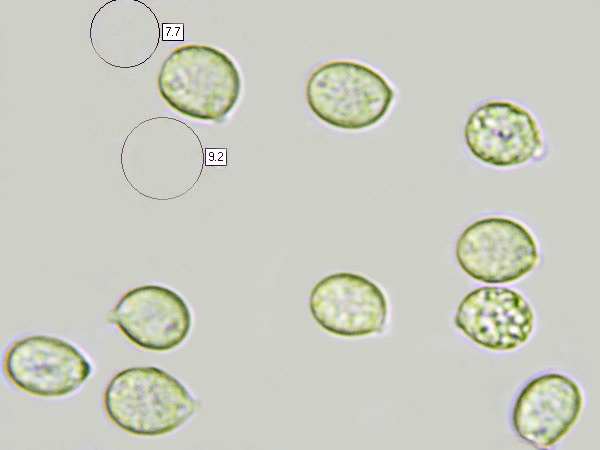Amanita gemmata (Fr.) Bertill. - Jewelled Amanita
Phylum: Basidiomycota - Class: Agaricomycetes - Order: Agaricales - Family: Amanitaceae
Distribution - Etymology - Taxonomic History - Psychoactivity - Identification - Reference Sources
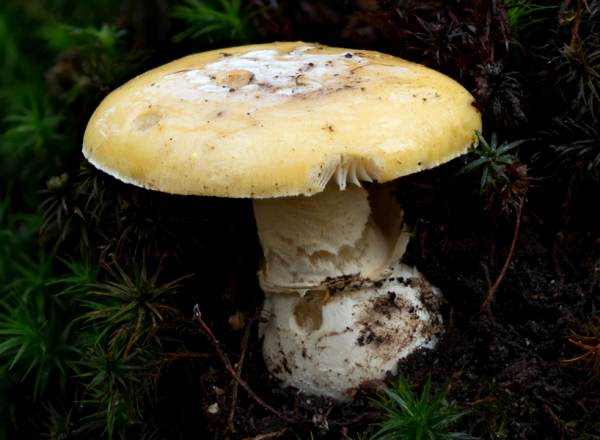
Amanita gemmata is indeed a gem of a mushroom, although it is known to be poisonous - causing symptoms similar to those associated with the Fly Agaric, Amanita muscaria. Commonly referred to as the Jewelled Amanita, this rare find in Britain and Ireland is common in central and southern Europe.
Amanita gemmata is known to be genetically close to Amanita muscaria, the Fly Agaric, and this close relationship should be a warning that this is not an edible mushroom.
For a detailed description of the Amanita genus and identification of common species see our Simple Amanita Key...
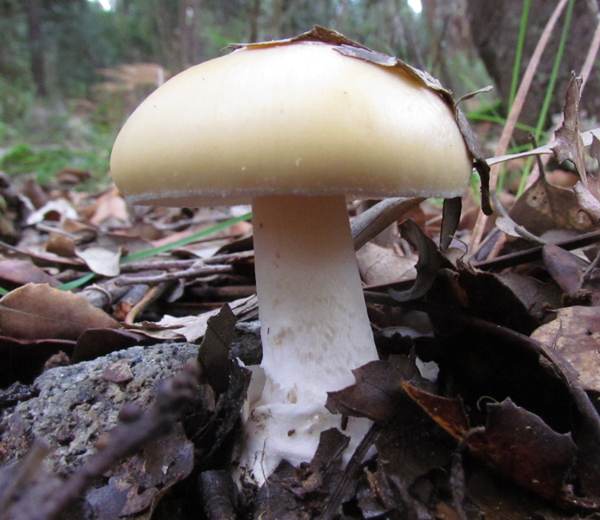
Distribution
Rare in Britain and Ireland, Amanita gemmata is very common in southern Europe, especially on the west coast of France and in northern and central Portugal. I have also come across these lovely little mushrooms in pine and cork oak woodland in the Algarve. This species is also recorded in many parts of North America (although it is as yet unclear whether they are in fact the same species as Amanita gemmata from Europe), and in parts of Asia and North Africa.
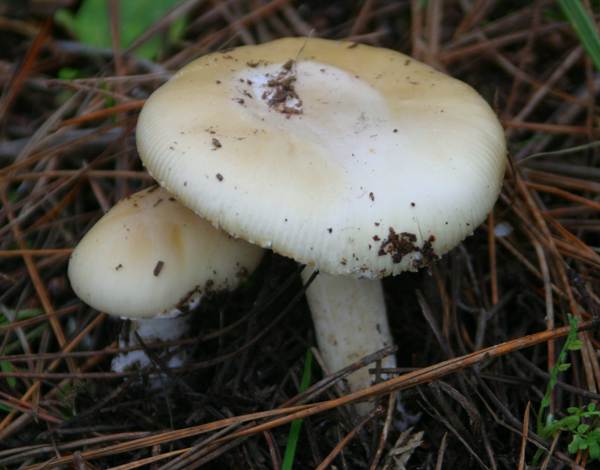
Taxonomic history
This species was first described scientifically in 1838 by the great Swedish mycologist Elias Magnus Fries, who named it Agaricus gemmatus. (Most of the gilled mushrooms were included initially in the genus Agaricus!) In 1866 the French statistician Louis-Adolphe Bertillon (1821 - 1883) transferred it to the genus Amanita, when its name became Amanita gemmata. Synonyms of this species include Amanita muscaria var. gemmata Quél., Amanitopsis gemmata Sacc., Amanitaria gemmata J-E Gilbert, and Venenarius gemmatus Murrill. Amanita junquillea Quél. is also considered by some authorities to be synonymous with Amanita gemmata.
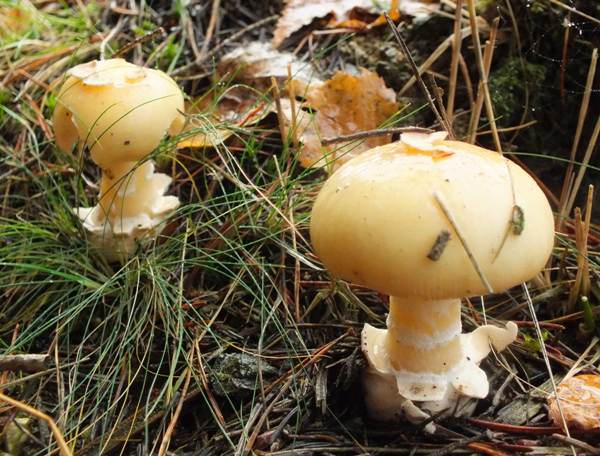
Above: Amanita gemmata, New Forest, Hampshire UK in early December.
Etymology
The specific epithet means gemmed or jewelled, and some people refer to Amanita gemmata as the Gemmed Amanita.
Psychoactive alkaloid content of Amanita gemmata
The Jewelled Amanita is known to contain the same psychoactive chemical compounds - ibotenic acid and muscimol - as are found in the hallucinogenic Fly Agaric, Amanita muscaria. (The concentrations of toxins in Amanita gemmata may be variable, and some authorities believe that this species may hybridise with Amanita pantherina, another hallucinogenic and hence toxic toadstool.) Amanita gemmata must therefore be treated as a toxic toadstool and should not be gathered for eating.
Identification guide
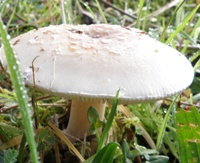 |
CapThis lovely little mushroom of sandy soil nearly always has veil patches adhering to the pale ochre cap, which expands until flat or occasionally slightly depressed in the centre. Pale ochre with darker centre; retaining white veil fragments mainly in centre; convex, flattening; 5 to 9cm across. |
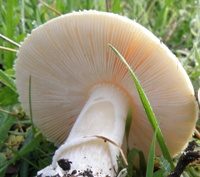 |
GillsWhite; adnexed; crowded. |
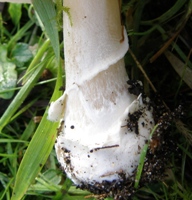 |
StemWhite, tinted ochre; 7 to 10cm long, 1 to 1.5cm diameter; a short-lived stem ring falls away to leave an indistinct mark low down on stem; there is a short volva around its slightly swollen stem base. |
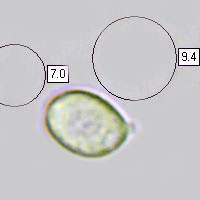 |
SporesBroadly ellipsoidal to globose, smooth, 9-11 by 7-8.5µm; inamyloid. Spore printWhite. |
Odour/taste |
Not significant |
Habitat & Ecological role |
Mycorhizal with conifers, particularly pines, but occasionally reported from sites containing only hardwood trees (and possibly, therefore not actually the same Amanita species!), Amanita gemmata is most commonly seen on sandy soil in coastal pine forests on stable sand dunes. |
Season |
July to late November in Britain; several weeks later in southern Europe. |
Similar species |
Amanita citrina is usually larger and paler with white or citrine cap patches and a prominent stem ring. |
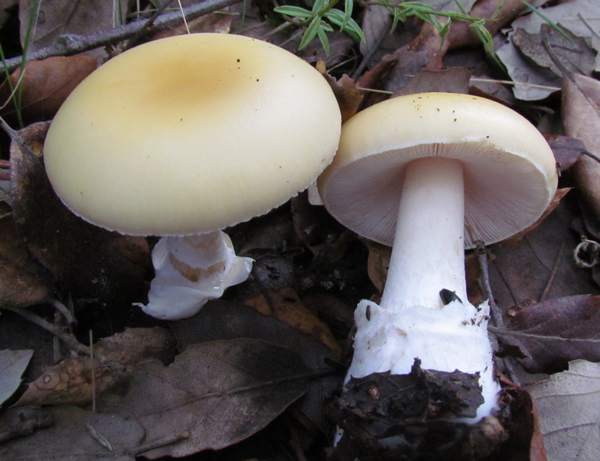
Reference Sources
Fascinated by Fungi, 2nd Edition, Pat O'Reilly 2016, reprinted by Coch-y-bonddu Books in 2022.
BMS List of English Names for Fungi
Geoffrey Kibby, (2012) Genus Amanita in Great Britain, self-published monograph.
Funga Nordica: 2nd edition 2012. Edited by Knudsen, H. & Vesterholt, J. ISBN 9788798396130
Paul M. Kirk, Paul F. Cannon, David W. Minter and J. A. Stalpers (2008). Dictionary of the Fungi; CABI
Taxonomic history and synonym information on these pages is drawn from many sources but in particular from the British Mycological Society's GB Checklist of Fungi.
Acknowledgements
This page includes pictures kindly contributed by David Kelly.
Fascinated by Fungi. Back by popular demand, Pat O'Reilly's best-selling 450-page hardback book is available now. The latest second edition was republished with a sparkling new cover design in September 2022 by Coch-y-Bonddu Books. Full details and copies are available from the publisher's online bookshop...
